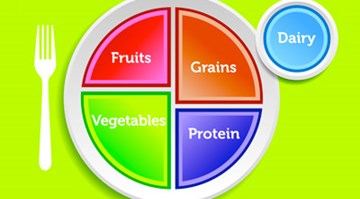Whether you are cooking for just yourself or a larger group, planning meals is a good place to start improving your food choices. Taking the time to plan a healthy evening meal can help you avoid a less healthful "drive-through" dinner— and save you money in the process.
And we all know that eating a diet rich in vegetables and fruits can have many health benefits. It may reduce risk for heart disease, protect against certain types of cancer and reduce your risk of type 2 diabetes.
Here are some tips:
Make a Weekly Meal Plan
- Before making a grocery list, decide on the meals you want to make. Buying for the week means fewer shopping trips. Plus you’ll buy only the things you need.
Meal Planning Basics
- See what you already have in your fridge or cupboards. No need to buy things you lready have in stock.
- Make a list or keep a notebook of new recipes to try.
- Think about your schedule. If you have a busy week, plan easy meals.
- Get more servings out of your favorite recipes! Add frozen vegetables to favorite pasta dishes, or beans to burgers to serve more meals.
- Plan to use leftovers. Make larger recipes with enough servings for extra meals.
- Picture the plate. Vegetables and fruits should cover half. Lean protein should cover a quarter, and the rest should be whole grains.
- Look for sales. What’s on sale this week? And don’t forget coupons!
Make Healthy Choices and Save Money
- Reduce portion sizes and buy fewer high-calorie foods.
- For example, sodas and flavored drinks are mostly empty calories. Use less costly sparkling water and serve with a splash of a 100% fruit juice.
- Read the label. Compare two different items by reading the Nutrition Facts and choose the healthier option.
- Have a meatless meal once a week or more to take in more. Eggs are a great source of protein and can be eaten for breakfast, lunch or dinner.
- Choose lower-calorie ingredients.
- In casseroles and meat sauces with a cream soup base, use a low-fat version.
- Use low-fat instead of full-fat cheese in casseroles and vegetable sauces.
- Use a lower-fat ground beef such as ground round or sirloin in tacos or pasta sauces. Or try using skinless ground turkey breast. After browning, drain the excess fat.
Kitchen Timesavers
- By taking the stress and hassle out of cooking, you’ll have more time to enjoy it.
- Organize your kitchen. Keep frequently used items such as cooking oils/sprays, spatulas, cutting boards, and spices within easy reach.
- Clear the clutter. Before you start cooking, clear off your counters. This allows more room for prep space.
Other things to know:
- Eat before you shop. Grocery shopping hungry can lead to impulse buying and unhealthy food choices.
- Keep it simple. Healthy and creative meals don't have to be complicated. A simpler menu will usually cost less money and will be easier to prepare in the end.
Try these healthy recipes:
Brown Rice with Sizzling Chicken and Vegetables
Learn more about helathy eating at ChooseMyPlate.gov.






